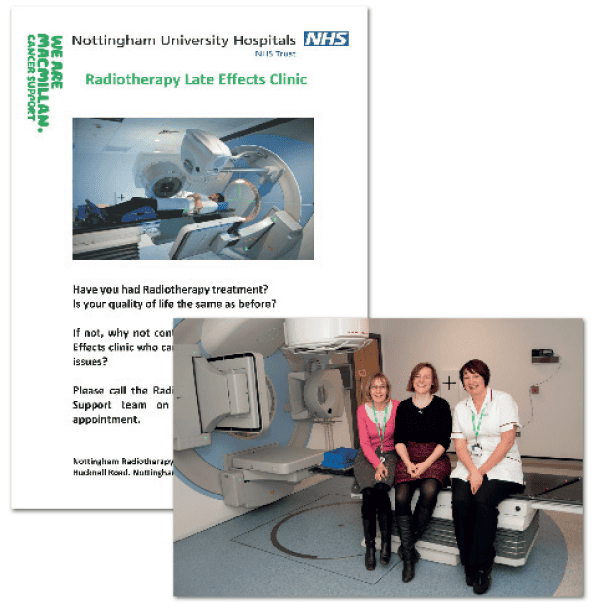Summary
The number of people being cured of their cancer is increasing but as they live longer, many are now coming forward, cured of their disease but living with significant late effects of treatment. Radiotherapy, in particular, is known for causing late effects mostly through a process of tissue fibrosis and reduction in blood flow. At the RTLE clinic at NUH, patients can self-refer. From there, they can either be given information about managing their RTLE or clear and open pathways to access a wide array of specialist interest clinical teams and services within the Trust.
Challenge
Radiotherapy (RT) is an essential curative treatment involved in the management of 40% of patients who are cured of cancer. Cancer survival is at its highest ever, with significant improvements being made over the last 15 years and more than half of people receiving a cancer diagnosis will now live ten years or more. But one in four people who have been treated for cancer live with ill health or disability as a consequence of their treatment.
It is imperative that radiotherapy departments have a comprehensive RTLE programme to ensure that patients access the correct care by specialist teams in a timely manner. Yet currently very few radiotherapy departments within the UK run an RTLE programme, almost none is fully comprehensive over all tumour sites and none is staffed by clinical teams fully trained in radiotherapy treatment.
Objectives
These included: to better inform patients and GPs about RTLE at the end of their radiotherapy treatment and how to access support; to source specialist clinical teams within the Trust who had an interest in or who were keen to develop an interest in RTLE and build a relationship with them; to develop rapid and clear pathways of referral to the specialist clinical teams; and to create a ‘one-stop’ RTLE clinic to which patients could self-refer.
Solution
Patients finishing radiotherapy treatment were given an information letter concerning what RTLE they might expect and how to access the RTLE clinic. Clinical teams across the Trust were sought and identified who already had expertise in managing specific radiotherapy late-effects or who were interested in developing their own practice to become expert. Teams included: chronic pain team, restorative dentistry, endocrine service, lymphoedema and psychological support services. Training was provided for the radiographers in some areas to allow lower level symptoms to be dealt with from the RTLE clinic and avoid the need for referral back to medical clinics. The RTLE clinic was established following the development of the clinical pathways. It was designed to be an open access clinic for patient self-referral in addition to referrals from clinical teams. Community liaison was seen as a key priority as many of our target patients might no longer be in routine cancer follow-up. Meetings were sought with GP cancer groups and visits were made to a variety of community cancer teams and self-help groups. An open day event was held within the radiotherapy department.
Results
Most important are the patient outcomes in terms of Quality of Life. 60 patients have been seen so far in the RTLE clinic with follow-up outcome data available on 28. Holistic Needs Assessments (HNA) from the RTLE clinic and after 6 months follow-up have shown an overall reduction in the Holistic Needs score by an average of 2.4 points (Range 0-6). This is highly significant. Few interventions in this complex group of patients have ever shown any ability to improve their QoL.
Learnings
As our model is simple, it can be led by staff already within radiotherapy departments and works the entire process of radiotherapy together. The programme must be embedded within the whole cancer community for patients to be enabled to seek support for their late effects. This whole RTLE programme has been run by two information and support radiographers working only one day per week on the programme with additional support two hours per week from a clinical oncologist.Evaluation
From September 2014 until October 2015 we have seen 60 clinic referrals; 31 female and 29 male and demand is increasing as the clinic grows in reputation. The average age of the patients was 64 years (range 31 – 85). The mean time from end of radiotherapy to attending the RTLE clinic was 3.67 years (range 4 months to 30 years). Of the major tumour types represented in the RTLE clinic, 30% were head and neck cancer, 28% were breast cancer and 17% prostate cancer. 32% of patients had received radiotherapy to the pelvis. 34% of patients self-referred, 61% were referred by clinical teams within the Trust and only 5% were referred by GPs – a disappointing number. Only 25% of patients required referral to medical teams for ongoing investigations and formal review in medical clinics. Referral back into medical clinics would normally be how these patients’ symptoms are managed. It is difficult to accurately calculate the efficiency cost-savings we have achieved but it is clear that they are significant.



